



Appliance is filled with flammable gas R290.

Before installing and using the appliance, read the owner manual.

Before installing the appliance, read the installation manual.

Any repairs you need, contact the nearest authorized Service Centre and strictly follow manufacturer's Service Manual.
The Refrigerant R290
Do not try to accelerate the defrosting process or to clean the appliance in different ways other than those recommended by the manufacturer. Should repair be necessary, contact your nearest authorized Service Centre. Any repairs carried out by unqualified personnel may be dangerous. The appliance has to be stored in a room that doesn't have any continuously operating ignition sources. (for example: open flames, an operating gas appliance or an operating electric heater.) Do not pierce or burn.
Appliance has to be installed, used and stored in a room with a floor area larger than 14 m 2 . For repairs, strictly follow manufacturer's instructions only for appliances filled with R290 flammable gas. Be aware that refrigerants do not have any odour.
In the event of an anomaly, switch the appliance off and unplug it from the socket. Do not dismantle or attempt to repair or modify the product. In the event of a malfunction, contact the service centre directly.
The manufacturer will not be held liable if safety and accident prevention rules are not observed.

Min/max operating limits (internal temperature)
Cooling: 16°C DB / 35°C DB
Dehumidification: 16°C DB / 35°C DB
Heating: 7°C DB / 35°C DB
Cooling mode room temperature adjustment range: 16°C DB / 31°C DB
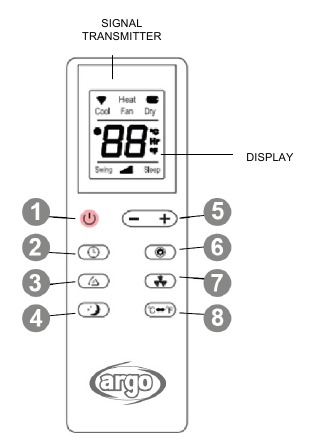
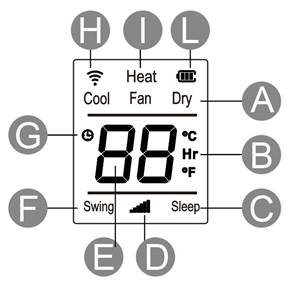



| Problem | Cause | Solution |
| FL | Tank full of water. | Empty the tank. If the problem persists, contact a service centre. |
| E1 | Room temperature sensor failure. | Contact a service centre. |
| E2 | Failure of temperature sensor on the evaporator. | Contact a service centre. |
The temperature and error display lights up only in COOL modes. In DRY and FAN modes it does not light up.

The following space must be maintained to ensure the operating efficiency of the portable air conditioner. The unit must be placed vertically for 2 hours before the first power on.
Open the packaging and remove the box from above. Remove the product and the other elements supplied (illustrated in the box below).

Position the product vertically on a flat and stable surface, as close as possible to a window and at least 50 cm from walls or other nearby obstacles.

Connect the flat fitting to the hose, extend the hose as far as necessary for reaching the outside and it connect to the back of the air conditioner.

Connect the round window fitting (1) to the end of the hose then the end fitting for the window (2)
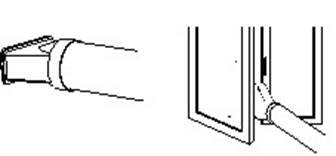
Open the windows and lock one of the two leaves with the handle.
Place the end fitting against the fixed leaf of the window, and draw the other leaf towards it.

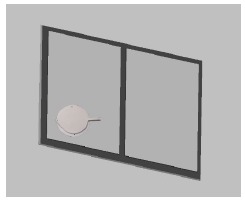


Connect the power cord to a suitable electric socket (220–240 V). Insert the supplied batteries into the remote control and make sure the poles match. Select the desired operating mode from the remote control.
This appliance can be used for cooling, dehumidifying and ventilating.
When switching between modes, the fan continues to rotate but the compressor stops: the compressor will start after 3 minutes. This delay protects the compressor from potential damage.

Cooling, Fan, Heating* (*available only on IRO PLUS)

Dehumidifying
THE DISCHARGE TUBE MUST ALWAYS BE CONNECTED to the appliance: the only exception is when the appliance is used solely for dehumidification, in which case it is advisable to let the appliance discharge directly into the environment for maximum efficiency (consult the "Dehumidification Mode" paragraph).
Regularly clean the air filters beneath the easily removable rear grille to keep the air conditioner working efficiently.
* Available only in IRO PLUS model.
NOTE
The air conditioner does not cool the room when operating as a dehumidifier.
When the appliance is used as a dehumidifier, the flexible pipe must not be connected.
For maximum dehumidification efficiency, leave the rear discharge attachment free to discharge directly into the environment.
The dehumidification mode is recommended during autumn and winter.
If used during summer, it is best to leave the flexible pipe attached so that the hot air is discharged towards the outside rather than into the room.
During dehumidification, continuous drainage should be implemented (see the next chapter, "HOW TO ELIMINATE CONDENSATE").
This appliance automatically vaporizes the condensation in Cooling.
When the air conditioner operates in Cooling mode, it is not necessary to have continuous condensate drainage; only in particular climatic conditions in which the air humidity is very high, it can happen that water is deposited inside the unit.
In Heating mode the condensate is not vaporized automatically, it will therefore be necessary to empty the tank periodically. Alternatively, drainage can be arranged from the lower hole on the back of the unit, the condensate drain will be intermittent.
When the internal tank is full, the air conditioner will emit 8 beeps and the display will show the message "FL", signaling the filling and blocking the operation of the appliance.
When the unit operates in the cooling and heating mode, ensure that the rubber cap closing the drainage opening on the back of the appliance is properly positioned.

To empty the container, switch the air conditioner off and unplug the cord. Remove the cap from the rear drainage opening and place its end over a normal drain. Ensure that the tube is not twisted or bent. The tube must slope downwards. Re-close the drainage opening with the cap, insert it into the clamp and resume use of the air conditioner.
When using the air conditioner in dehumidification mode, we recommend always ensuring continuous drainage, in order to maximise dehumidification efficiency.
Use the drainage outlet on the appliance. The water can be drained into a drain by simply connecting the supplied drainage tube.




Insert the batteries into the remote control, while respecting the indicated polarities.
Only use alkaline batteries type AAA, LR03 1,5 V compliant with the Batteries Directive 2006/66 / EC and modifications pursuant to Directive 56/2013 / EU.
Remove the batteries if the remote control is not used for a month or longer.
Do not attempt to recharge the batteries. Replace all batteries at the same time.
Do not throw the batteries into fire: they may explode.

INFORMATION FOR CORRECT DISPOSAL OF THE BATTERIES PURSUANT TO EUROPEAN DIRECTIVE
2006/66/EC and amendments former Directive 2013/56/UE
Replace the batteries when depleted. At the end of their working life, batteries must be disposed of separately from unsorted waste. They must be must be delivered to appropriate separated waste disposal plants or to dealers that provide a similar service. Separate waste disposal of batteries prevents potential negative effects on the environment and human health resulting from inadequate disposal, and also allows the materials from which it is made to be recovered and recycled in order to achieve significant savings in terms of energy and resources. The separate disposal obligation is underlined by the crossed-out dustbin symbol appearing on the battery. Illegal disposal of the product by the user is subject to administrative penalties as per current regulations.
FOR OPTIMUM OPERATION OF THE REMOTE CONTROL, ADDRESS THE TRANSMITTER HEAD TOWARDS THE RECEIVER LOCATED ON THE AIR CONDITIONER.
Prior to carrying out any cleaning or maintenance, unplug the unit from the power socket.

The lower filter grid is blocked by a screw and the filter can only be cleaned from the outside, using a vacuum cleaner.

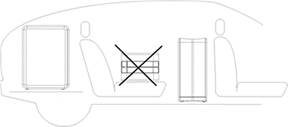
CHECK that:
REGULATION (EU) No. 517/2014 – F-GAS
IRO
The unit contains R290, a natural greenhouse gas with global warming potential (GWP) = 3 - Kg. 0.22 = 0.00066 Tons CO2 equiv.
Do not release R290 into the atmosphere.
IRO PLUS
The unit contains R290, a natural greenhouse gas with global warming potential (GWP) = 3 - Kg. 0.23 = 0.00069 Tons CO2 equiv.
Do not release R290 into the atmosphere.

Here you can download full pdf version of manual, it may contain additional safety instructions, warranty information, FCC rules, etc.